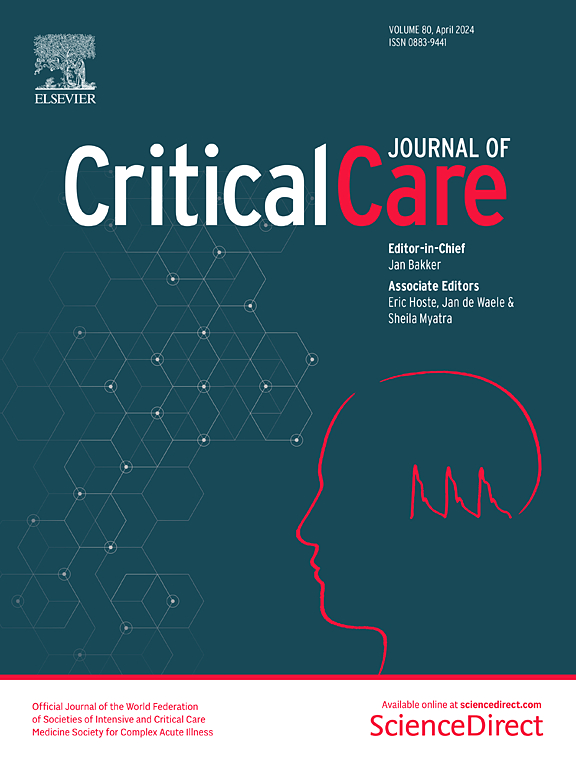外源性乳酸盐输注(ELI)治疗创伤性脑损伤:剂量越大效果越好?
IF 8.8
1区 医学
Q1 CRITICAL CARE MEDICINE
引用次数: 0
摘要
创伤性脑损伤(TBI)是一种危及生命的严重神经损伤,会导致广泛的代谢功能障碍,需要新型代谢疗法。外源性乳酸盐似乎可以改善脑代谢,但所需的乳酸盐剂量仍不确定。然而,乳酸盐的理想剂量仍不明确。我们在一个小型队列中对低剂量和高剂量外源性乳酸钠输注进行了比较,并参考了之前的文献。我们提出了一个系统性方案,以便在未来更大规模的研究中更好地研究剂量效应问题。我们分析了不同剂量的外源性乳酸钠输注(ELI)对现有已发表文献和我们自己的单中心严重创伤性脑损伤昏迷患者队列的代谢和生理效应。以动脉乳酸浓度 2-3 毫摩尔为目标的低剂量 ELI 与以 4-6 毫摩尔为目标的高剂量 ELI 进行了比较。回顾了ELI对脑代谢和颅内压(ICP)的影响。对精确的高剂量方案进行了试验,并将结果与现有文献进行了比较。在各项研究中,ELI的代谢反应各不相同,而且并非始终有益。以 4-6 毫摩尔动脉浓度为目标的大剂量 ELI 可持续改善代谢和降低 ICP(p < 0.01)。精确的高剂量方案能可靠地提高动脉浓度。大剂量 ELI 似乎对脑代谢和颅内压具有更一致的有益影响。ClinicalTrials.gov ID NCT02776488。注册日期:2016-05-17。回顾注册。本文章由计算机程序翻译,如有差异,请以英文原文为准。
Exogenous lactate infusion (ELI) in traumatic brain injury: higher dose is better?
Traumatic brain injury (TBI) is a life-threatening critical neurological injury resulting in widespread metabolic dysfunction in need of novel metabolic therapy. Exogenous lactate appears to improve brain metabolism, but the dose of lactate required remains uncertain. However, the ideal dose of lactate remains unclear. We present a comparison of low vs high dose exogenous sodium lactate infusion in a small cohort and the previous existing literature. We propose a systematic protocol to better study the question of dose–effect n in a future larger study. We analyzed the metabolic and physiologic effects of various doses of exogenous sodium lactate infusion (ELI) in the existing published literature and our own, single center cohort of patients with coma from severe TBI. Low dose ELI targeting arterial lactate concentration of 2–3 mMol was compared with high dose ELI targeting 4–6 mM. Effects of ELI on brain metabolism and intracranial pressure (ICP) were reviewed. A precision high-dose protocol was piloted and results compared against the existing literature. Across various studies, metabolic response to ELI was variable and not consistently beneficial. High-dose ELI targeting arterial concentration of 4–6 mM resulted in consistent metabolic improvement and in ICP reduction (p < 0.01). The precision high dose protocol reliably resulted in higher arterial concentration. High dose ELI appears to have more consistent beneficial effects on brain metabolism and intracranial pressure. ClinicalTrials.gov ID NCT02776488. Date registered: 2016-05-17. Retrospectively Registered.
求助全文
通过发布文献求助,成功后即可免费获取论文全文。
去求助
来源期刊

Critical Care
医学-危重病医学
CiteScore
20.60
自引率
3.30%
发文量
348
审稿时长
1.5 months
期刊介绍:
Critical Care is an esteemed international medical journal that undergoes a rigorous peer-review process to maintain its high quality standards. Its primary objective is to enhance the healthcare services offered to critically ill patients. To achieve this, the journal focuses on gathering, exchanging, disseminating, and endorsing evidence-based information that is highly relevant to intensivists. By doing so, Critical Care seeks to provide a thorough and inclusive examination of the intensive care field.
 求助内容:
求助内容: 应助结果提醒方式:
应助结果提醒方式:


